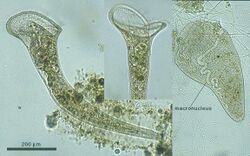Biology:Stentor (ciliate)
| Stentor | |
|---|---|

| |
| Stentor roeselii | |
| Scientific classification | |
| Domain: | Eukaryota |
| Clade: | Diaphoretickes |
| Clade: | SAR |
| Clade: | Alveolata |
| Phylum: | Ciliophora |
| Class: | Heterotrichea |
| Order: | Heterotrichida |
| Family: | Stentoridae Carus, 1863 |
| Genus: | Stentor Oken, 1815 |
| Species | |
| |
Stentor, sometimes called trumpet animalcules, are a genus of filter-feeding, heterotrophic ciliates, representative of the heterotrichs. They are usually horn-shaped, and reach lengths of two millimeters; as such, they are among the largest known extant unicellular organisms. They reproduce asexually through binary fission.[1]
Description
The body, or cortex, is generally horn-shaped, hence the association with the Greek herald, and the former name "trumpet animalcule". A ring of prominent cilia around the anterior "bell" sweep in food and aid in swimming. Some reach several millimeters in length, making them among the largest single-celled organisms. Stentor can come in different colors: for example, S. coeruleus can appear blue due to the presence of stentorin, a natural pigment. As in many freshwater protozoans, Stentor has a contractile vacuole. Because the concentration of salt inside the cell and in the surrounding freshwater is different, Stentor must store water that enters it by osmosis and then discharge it from the vacuole. They can regenerate, and small fragments can grow into full organisms. Each cell has one (often elongated) macronucleus and several micronuclei.
Ecology
These protists are common worldwide in freshwater lakes and streams; only S. multiformis has been recorded from marine, freshwater, and even terrestrial biotopes. They are usually attached to algal filaments or detritus. Some Stentor species, such as S. polymorphus, can live symbiotically with certain species of green algae (Chlorella). After being ingested, the algae live on while their host absorbs nutrients produced, whereas the algae, in turn, absorb and feed on the Stentor's metabolic wastes. Stentor species react to outside disturbances by contracting into a ball. Resting cysts are known from a few species.[2]
Systematics
The genus contains over twenty described species (see list in box).[3][4] The genus Stentor was named in 1815 by the German biologist Lorenz Oken (1779–1851).[5]
The type species of the genus is Stentor muelleri Ehrenberg, 1831. According to recent molecular analyses, the genus seems to be monophyletic, and related to the genus Blepharisma.[6]
Video gallery
| File:Stentor muelleri.ogg | File:Stentor dividing.ogv | File:Stentor muelleri at 1000X.ogv |
See also
- Stentor (disambiguation)
References
- ↑ "Stentor". Microbewiki.kenyon.edu. https://microbewiki.kenyon.edu/index.php/Stentor.
- ↑ Tartar, Vance (1961). The biology of Stentor. International series of monographs on pure and applied biology: Division, Zoology. 5. Pergammon Press. OCLC 558125. https://books.google.com/books?id=LZrwAAAAMAAJ.
- ↑ Kumazawa, H. (2002). "Notes on the taxonomy of Stentor Oken (Protozoa, Ciliophora) and a description of a new species". J. Plankton Res. 24 (1): 69–75. doi:10.1093/plankt/24.1.69.
- ↑ Foissner, W.; Wölfl, S. (1994). "Revision of the genus Stentor Oken (Protozoa: Ciliophora) and description of S. araucanus nov. spec. from South American lakes". J. Plankton Res. 16 (3): 255–289. doi:10.1093/plankt/16.3.255.
- ↑ See:
- Oken, Lorenz (1815) (in de). Okens Lehrbuch der Naturgeschichte. Dritter Theil: Zoologie. Erste Abtheilung: Fleischlose Thiere.. Leipzig, (Germany): C.H. Reclam. p. 45. https://books.google.com/books?id=4xpAAQAAMAAJ&pg=PA45. From p. 45: "4 Gattung. Trichtel, Stentor; Leib gestielt, Mundrand umgelegt, durchsichtig. Sitzt gewöhnlich mit dem Stiel fest an Wasserlinsen, meist in Gesellschaft." (4th genus. Little funnel, Stentor; stalked body, rim of the mouth is wrapped around, transparent. Usually sits with the stalk fastened to duckweed, mostly in colonies.)
- Aescht, Erna (2001). Catalogue of the Generic Names of Ciliates (Protozoa, Ciliophora). Linz, Austria: Biologiezentrum des Oberösterreichischen Landesmuseums (Center for Biology of the State Museum of Upper Austria). pp. 153, 251, 307. https://www.zobodat.at/pdf/DENISIA_0001_0001-0350.pdf.
- ↑ "Molecular phylogeny of Stentor (Ciliophora: Heterotrichea) based on small subunit ribosomal RNA sequences". J. Eukaryot. Microbiol. 54 (1): 45–8. 2007. doi:10.1111/j.1550-7408.2006.00147.x. PMID 17300519. http://ir.ihb.ac.cn/handle/152342/8710.
External links
- Walker, D.. "Protozoa — The Stentor". Micscape. http://www.microscopy-uk.org.uk/mag/articles/stentor.html.
- "Stentor: The trumpet animalcule (3D image)". Micscape. ISSN 1365-070X. http://www.microscopy-uk.org.uk/mag/art98/stent.html.
- Tartar, Vance. (1961) The biology of Stentor. New York, Pergammon Press. https://archive.org/details/biologyofstentor00tart
Wikidata ☰ Q1202152 entry
 |





